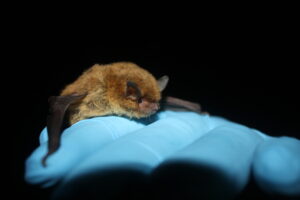Southeastern Bat
Scientific Name: Myotis austroriparius
Description.
Like other bats in the genus Myotis, this bat can be described as small and brown. They generally weigh from 5 to 8 grams, with females being slightly larger than males. Wingspan ranges from 240 to 270 mm. The fur has a wooly appearance and is not glossy like that of the little brown bat, Myotis lucifugus. The face is bare and pinkish. The calcar is not keeled. Hairs on the foot may extend well beyond the ends of the claws. The southeastern bat is known to have large hind feet.
Distribution.
This species occurs in bottomland habitats throughout the Coastal Plains of southeastern states and along the Mississippi River, once as far north as Indiana and Illinois.
Ecology and Behavior.
The Southeastern bat is closely associated with water and forages over it, flying close to the surface. Within the section of range which possesses caves, the bats utilize caves for summer and winter roosts, generally preferring ones near or containing a water source. In North Carolina and other areas lacking caves, southeastern bats roost in hollow tupelo, gum, or cypress trees in bottomland hardwood forests. Buildings, bridges, culverts, and other manmade structures can also be utilized by bats for their roosts.
Food and Feeding.
Studies on feeding behavior of the southeastern bat have shown that they feed mainly on mosquitoes, crane flies, small moths, small beetles, and other small insects.
Reproduction and Development.
Unique among bats in the genus Myotis, southeastern bats generally produce twins. Females form summer nursery colonies containing up to several thousand individuals. Males form small bachelor colonies, or roost singly, separate from the nursery colonies. Pups are born in late spring generally weighing around 1 gram without fur and closed ears and eyes. The young begin to fly at five to six weeks of age.
Status.
Southeastern bats are listed at both State and Federal levels as species of concern. Though widespread throughout the Coastal Plain, their numbers have declined due to habitat loss and degradation.
- Click here to see where you can find the Southeastern Bat in NC!
